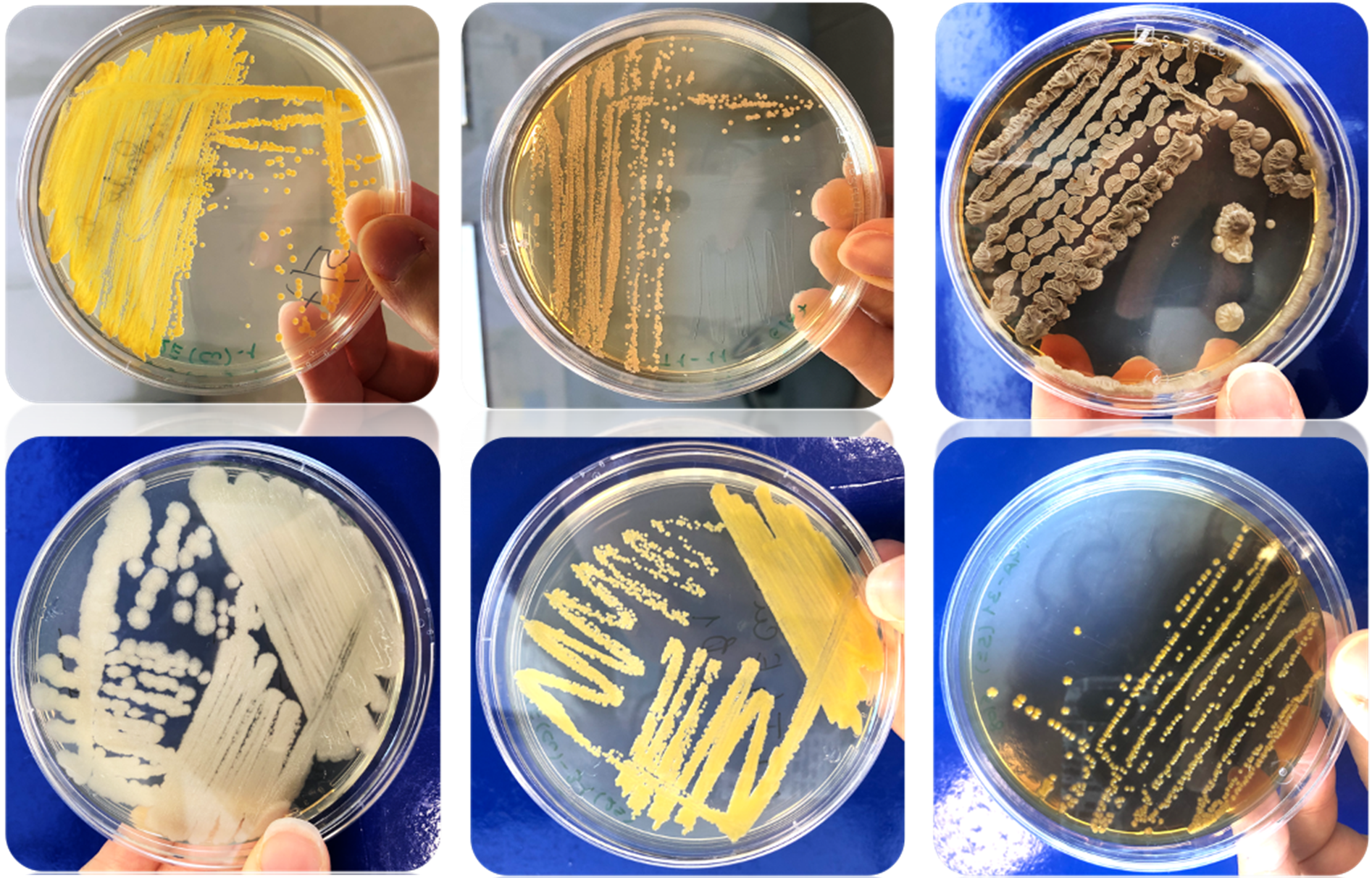09 Nov Progress of GT3
GT3 focuses on conservation (in situ and ex-situ) and promotion of biodiversity at mining sites. Efforts will focus on the conservation of metal plants and metallophytes, as well as other organisms (animals, micro-organisms) adapted to environments with high levels of metals, for future biotechnological applications.
Monitored sites are:
- Sentein-Bulard
- Bandeira
- Lanestosa
- Borralha
Following, a brief overview of works carried out until November 2022.
Sentein
The lockdown and the snow made the work here started later than thought. The isolation and characterization of culturable bacterial strains are being carried out by NEIKER. The Portuguese team also expects to receive soil samples for analysis.
Assessment of plant diversity
Several species with interest for phytoremediation were identified, namely: Agrostis capillaris (metal(loid) excluder), Armeria muelleri (bioindicator – metallophyte), Festuca ovina (metal(loid) excluder), and Minuartia Verna (metallophyte).
Microbial strains with biotechnological potential
Fifty-two bacterial strains were isolated from rhizospheric soil. Plant-growth-promoting traits such as siderophore production, phosphate solubilization, aminocyclopropane-1-carboxylate (ACC) deaminase activity, indole-3-acetic acid (IAA) production, and biosurfactant production were assessed. A phenotypic characterization is being carried out in the best-performing strains. Some strains were selected to form bacterial consortia. For this purpose, biofilm production, bacterial compatibility test, and metal tolerance are being assessed.
The trap cultures, established with soil collected in the mine to collect spores of arbuscular mycorrhizal fungi (AMF), are being processed.
Assessment and conservation of macroinvertebrate biodiversity
3 grasshoppers and 3 crickets were collected.
Bandeira
The vegetation surrounding the experimental plot is made up of natural vegetation, predominantly scrubland.
- Forest: isolated specimens of pines (Pinus pinaster) and cork oaks (Quercus suber).
- Scrub: Ericaceae (including Erica scoparea), gorse (Ulex europaeus) and some Genista.
- Herbaceous substrate: the most important species are Noccaea caerulescens, Lepidium heterofilum, Centaurea gallaecica, Potentilla montana, Glandora prostrata, Daboecia cantabrica, Pteridium aquilium, Asphodelus albus and various types of grass.
The quarry area just above the experimental plot is a very arid area with little vegetation cover and the absence of both scrub and forest vegetation. The most important species identified were Noccaea caerulescens, Lepidium heterophyllum, Sagina merinoi (Galician endemism), Silene uniflora and Cortaderia selloana.
Assessment of plant diversity
Two plant species of conservation interest – Noaccae caerulescens and Silene uniflora subsp. uniflora were identified in the botanical survey. Seeds of these plants will be collected to build up the germplasm bank.
N. caerulescens is present in the forest/scrubland around the experimental plot in the quarry area and was found to hyper-accumulate Zn and Cd. In Galicia, populations of this species have only been identified in ultramafic substrates, showing Ni hyperaccumulating capacity. The plant species S. uniflora only occurs inland in ultramafic substrates.
Microbial strains with biotechnological potential
Rhizobacteria associated with N. caerulescens were isolated and their plant-growth-promoting traits are being assessed, namely siderophore production, phosphate solubilization, aminocyclopropane-1-carboxylate (ACC) deaminase activity, and indole-3-acetic acid (IAA) production.
Assessment and conservation of macroinvertebrate biodiversity
15 slugs and 5 snails were collected last July and sent to Biscay Bay Environmental Biospecimen Bank for analysis.
Lanestosa
The most frequent association is formed by red fescue (Festuca rubra, metal excluder and the most abundant species in the mine) and alpine pennycress (Noccaea caerulescens, formerly Thlaspi caerulescens, metal hyperaccumulator). This plant consortium is often accompanied by sheep’s-bit (Jasione montana, metal accumulator) and/or sorrel (Rumex acetosa, metal indicator), and less often by plantain (Plantago lanceolata, metal excluder). In the boundaries of the studied site, where the influence of mining activities is lower, the dominant species are gorse (Ulex europaeus), eagle fern (Pteridium aquilinum) and purple moor-grass (Molinia caerulea).
Botanical surveys and plant analysis in this area have already been carried out, identifying 145 plant species, and collecting 10 types of plants with their corresponding soil samples in July 2021. On the species for conservation the criteria of biomass production, abundance and endemism have been used. The isolation and characterization of culturable bacterial strains by NEIKER are being carried out. The first sampling visit was made on July 8th 2021, and the second on October 6th 2021 collecting a total of 30 sample individuals.
Assessment of plant diversity
Over 160 plant species, belonging to 63 families, were identified in the mine area. The concentration of metals in the soil and shoots of the species with interest were analyzed, and the metal tolerance strategy (accumulator/excluder) for each plant was identified.
Some plants of conservation concern were also identified:
- Noccaea caerulescens – can grow in ultrabasic soils,
- Cytisus cantabricus – it is an endemic species with the ability to stabilize soil and fix nitrogen.
- Jasione montana – plant protected in Europe (92/43/ECC) and Spain (RED 139/2011).
- Molinia caerulea – high biomass plant, suitable for soil stabilization.
- Festuca rubra – very good for soil stabilization, with a high coverage rate.
- Helictotrichon cantabrium – endemic sp. in the north of Spain and the south of Spain.
These species are preserved in the Bank of Germplasm of Olárizu.
Microbial strains with biotechnological potential
Fifty-three bacterial strains were isolated from rhizospheric soil and their plant-growth-promoting traits such as siderophore production, phosphate solubilization, aminocyclopropane-1-carboxylate (ACC) deaminase activity, indole-3-acetic acid (IAA) production, and biosurfactant production were assessed. A phenotypic characterization is now being carried out in the best-performing strains.
Some strains were also selected to form bacterial consortia. For this purpose, biofilm production, bacterial compatibility test, and metal tolerance are being assessed.
Assessment and conservation of macroinvertebrate biodiversity
A total of 21 slugs and 32 snails were collected and archived in Biscay Bay Environmental Biospecimen Bank for analysis.
Borralha
The vegetation cover at the site is composed of:
- Trees: pines (Pinus pinaster), oaks (Quercus robur; Q. rubra; Q. pyrenaica), willows (Salix salvifolia, S. atrocinerea), betulas (Betula pubescens), Robinia pseudoacacia.
- Shrubs: Ericaceae (including Erica umbellata; E. arborea), gorse (Ulex minor), Genista (Genista sp.), brooms (Cytisus multiflorus, Cytisus scoparius); Pterospartum tridentatum, etc.
- Herbs: Agrostis sp., Verbascum simplex, Digitalis purpurea, Senecio vulgaris, Centaurea gallaecica, Urtica sp., Pteridium aquilium, Rumex, Sedum arenarium, etc.
Assessment of plant diversity
A new plant survey was conducted last July, in 3 areas within the mine. Vegetation communities were identified by the relative frequency and dominance of each of the 3 pioneers-vegetation types (heathland, broom land, and grassland), from which 3 different species were selected. A total of 15 plant species (with 3 specimens per species) and their rhizospheric soil were collected. The metal concentration in plant tissues, and soil, is being assessed.
Microbial strains with biotechnological potential
Rhizospheric soil from the most abundant plant species (with the potential to be used in phytoremediation strategies) found in the tailings (Figure 1), was collected for microbial isolation.

Figure 1: Plant species found in Borralhas’ mine tailings and their metal tolerance strategy to metal(loid)s; Photos: @Sofia_Sousa
A total of 96 bacterial strains were isolated, and some examples can be seen in Figure 2. Based on bacterial metal tolerance and growth capabilities, 37 strains were selected for sequencing and identification. The assessment of their plant-growth-promoting traits such as siderophore production, phosphate solubilization, aminocyclopropane-1-carboxylate (ACC) deaminase activity, indole-3-acetic acid (IAA) production, and biosurfactant production is undergoing.

Figure 2: Morphology and colour of some strains collected in Borralhas’ mine tailings (Photo @Sofia Sousa)
Some strains were selected to form bacterial consortia. For this purpose, biofilm production and bacterial compatibility tests are being performed.
The trap cultures established with soil collected from the most abundant plants present in the tailings area are now being processed.
Assessment and conservation of macroinvertebrate biodiversity
Samples will be collected at the beginning of 2023.

